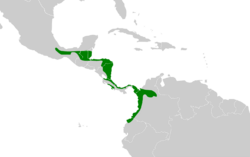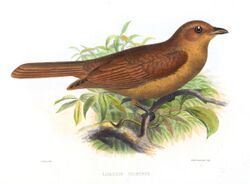Biology:Rufous piha
| Rufous piha | |
|---|---|

| |
| Scientific classification Error creating thumbnail: Unable to save thumbnail to destination
| |
| Domain: | Eukaryota |
| Kingdom: | Animalia |
| Phylum: | Chordata |
| Class: | Aves |
| Order: | Passeriformes |
| Family: | Cotingidae |
| Genus: | Lipaugus |
| Species: | L. unirufus
|
| Binomial name | |
| Lipaugus unirufus Sclater, PL, 1860
| |

| |
The rufous piha (Lipaugus unirufus) is a species of bird in the family Cotingidae. It is found in Belize, Colombia, Costa Rica, Ecuador, Guatemala, Honduras, Mexico, Nicaragua, and Panama. Its natural habitat is subtropical or tropical moist lowland forests.[1]
Description
The adult rufous piha is about 23.5 cm (9.3 in) long and the sexes look similar. The upper parts are a uniform reddish-cinnamon and the underparts are similar but a slightly paler shade, the throat being the palest part. The bill is broad and either flesh-coloured or brown at the base, and there is sometimes a slight ring round the eye. This bird could be confused with the speckled mourner (Laniocera rufescens) but that bird is shorter and more slender, with a slimmer bill and a relatively longer tail; the male rufous piha utters various piercing, whistling calls.[2][3]
Ecology
The rufous piha breeds between March and August in Costa Rica, there probably being two clutches in the year. The diet consists largely of fruits, such as those of laurels and palms, and invertebrates such as insects and spiders.[4] It lives in the middle and lower storeys of humid forest and seldom descends to ground level. Much of its food is plucked while it hovers, and anything gathered on the ground is carried aloft before being eaten.[5] It often sits lethargically on a suitable perch for long periods, sallying out at intervals to snap up passing insect prey.[3]
Status
The rufous piha has a very wide distribution and its total population is estimated to be within the range 50,000 to 500,000 individuals. The population may be in slight decline because of deforestation, particularly in Colombia and Ecuador, but not at a fast enough rate for it to be considered threatened, so the International Union for Conservation of Nature has rated it as being a "least-concern species".[1]
References
- ↑ 1.0 1.1 1.2 BirdLife International (2020). "Lipaugus unirufus". IUCN Red List of Threatened Species 2020: e.T22700859A137842114. doi:10.2305/IUCN.UK.2020-3.RLTS.T22700859A137842114.en. https://www.iucnredlist.org/species/22700859/137842114. Retrieved 11 November 2021.
- ↑ "Laniocera rufescens". Neotropical Birds. Cornell Lab of Ornithology. http://neotropical.birds.cornell.edu/portal/species/overview?p_p_spp=484876.
- ↑ 3.0 3.1 Ridgely, Robert S.; Tudor, Guy (2009). Field Guide to the Songbirds of South America: The Passerines. University of Texas Press. p. 310. ISBN 978-0-292-71748-0. https://books.google.com/books?id=gC_A2fpBl1gC&pg=PA310.
- ↑ Snow, D. (2016). "Rufous Piha (Lipaugus unirufus)". Handbook of the Birds of the World Alive. Lynx Edicions, Barcelona. http://www.hbw.com/node/57026.
- ↑ "Lipaugus unirufus". Neotropical Birds. Cornell Lab of Ornithology. http://neotropical.birds.cornell.edu/portal/species/overview?p_p_spp=484236.
Further reading
- Skutch, Alexander F. (1969). "Rufous piha". Life Histories of Central American Birds III: Families Cotingidae, Pipridae, Formicariidae, Furnariidae, Dendrocolaptidae, and Picidae. Pacific Coast Avifauna, Number 35. Berkeley, California: Cooper Ornithological Society. pp. 66–76. https://sora.unm.edu/sites/default/files/journals/pca/pca_035.pdf#page=66.
Wikidata ☰ Q1302546 entry
 |



